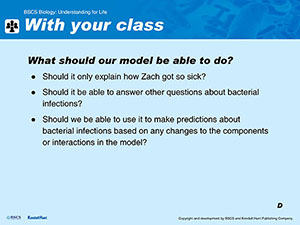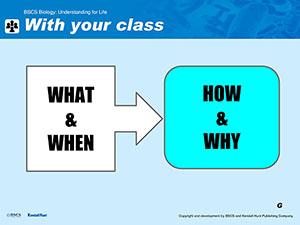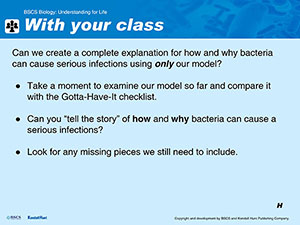CHAPTER 1 • LESSON 5 • SYNTHESIZE
How can bacteria cause infections?
PURPOSE | Connect key science ideas and build consensus around explaining an aspect of the Anchor phenomenon or problem.

TIME
Two 50-minute class periods
PREVIOUS LESSON | We figured out that bacteria are on us and in us all the time, but they only cause symptoms when particular types grow and reproduce in particular environments. This left us wondering how this process worked in Zach’s case and whether it always works the same way to cause symptoms.
THIS LESSON | We develop a model to figure out how all the ideas from this chapter connect with each other to explain how and why bacteria can sometimes make us sick. This leaves us wondering: how can we get better?
NEXT LESSON | We will figure out that our model does not explain how Zach got so sick, and almost didn’t get better. This leaves us wondering: How does the body respond when bacteria make us sick?

 LESSON LEARNING GOAL
LESSON LEARNING GOAL
Develop and use a consensus model to explain how entering the boundary of a new system can cause a bacterial population to grow quickly and how this growth can cause symptoms.
Lesson question
How can bacteria cause infections?
What students figure out
Understanding what bacteria are, what they need to live and grow, and how growth of bacterial populations can lead to symptoms explains how bacteria being transferred from one system to another, like from the environment to a human body, can cause an infection.
Understanding how bacterial infections spread and can cause us harm helps us explain why certain behaviors and actions can help prevent them.
What we are not expecting
Where we are not going yet
We are not yet investigating how the human immune system responds to bacteria.
Boundaries
We do not expect students to memorize which types of bacteria cause various diseases and how.
Relevant common student ideas
Only certain tissues, like blood or brain tissue, are made of cells. (All tissues are made of cells.)
Key literacy and sensemaking strategies
Scientists Circle
Students form a Scientists Circle for the second time in the unit (this structure for discussions was introduced in Lesson 1).
Communicating in Scientific Ways
To aid them with these discussion-based activities, students will also be introduced to the Communicating in Scientific Ways talk stems.
Gotta-Have-It Checklist
Students will build their first Gotta-Have-It Checklist in this lesson to help them plan for developing their Class Consensus Model.
Class Consensus Model
This is the first time students will collaboratively construct a Class Consensus Model to explain part of our unit Driving Question.
ASSESSMENT
Formative assessment: Prevention Policies
The Prevention Policies task is an opportunity for students to use what they learned to explain a related idea. It is also an opportunity for you to see how well students understand the usefulness of building a Gotta-Have-It Checklist, and the applicability of their model to a variety of questions or problems. Look for students to be building off the structures of the Class Consensus Model (rather than “reinventing the wheel”), including all key components and interactions, and showing how or why their prevention policy works.
Summative assessment: chapter 1 assessment
After completing this Synthesize Lesson, students should be prepared to take the chapter 1 assessment that follows. This assessment is appropriate for grading.
 SYNTHESIZE LESSON SNAPSHOT
SYNTHESIZE LESSON SNAPSHOT
Lesson 5: How can bacteria cause infections?
BIG IDEA | Bacteria can cause infections because as single-celled organisms that need resources to live and grow, bacterial populations may grow to a high level when introduced to our bodies, and the more of them there are, the more they may damage our cells and make us sick.
Routine |
Part |
Time |
Summary |
Slide |
Materials |
|
1 |
8 min |
Reflect on questions from the Driving Question Board. Students review the questions on the DQB, identify some that we might have answered, and consider if we know enough now to explain some of Zach’s case. Purpose: to recognize our learning and to motivate the need to link our ideas together to come up with a way to explain what happened to Zach. |
A–B |
Driving Question Board Science notebooks |
|
2 |
12 min |
Decide what our model needs to do. Drawing ideas from their Model Tracker, students discuss what a model would need to include or show for it to be able to explain what happened to Zach. They use these ideas to build a Gotta-Have-It Checklist that includes key components and interactions. Purpose: to organize our thinking and lift up all the components and interactions necessary to prepare for collaborating to develop an explanatory model. |
C–F |
Science notebooks Chart paper Chart markers |
|
3 |
30 min |
Construct a Class Consensus Model. Students work as a class to construct a Class Consensus Model to explain how bacteria can cause infections when they enter a new system. Purpose: to reach consensus on a model that could explain Zach and others getting a bacterial infection. |
G–H |
Science notebooks Chart paper Chart markers Gotta-Have-It Checklist |
Suggested class period break End of Day 1 |
|||||
|
4 |
10 min |
Reflect on the process of modeling. Students reflect on the modeling process, review their initial models (from Lesson 1), and consider how their ideas have changed. Purpose: to take stock of the different ways we have used models in this unit so far, appreciate their usefulness, and motivate their continued use throughout the unit. |
I |
Initial models (from Lesson 1) Gotta-Have-It Checklist Class Consensus Model Science notebooks |
|
5 |
30 min |
Use our models to explain prevention policies. Students read about how doctors who are concerned about the prevalence of infections like Zach’s encourage specific prevention policies. They adapt and use the class consensus model to make sense of how these policies could reduce the risk of serious infections. Purpose: to connect our learning so far with the societal issue (that some bacterial infections are becoming harder to treat) and see how understanding how infections start can help us prevent potentially life-threatening cases. |
J |
Student Sheet 1.5.B: Prevention Policies Gotta-Have-It Checklist Class Consensus Model |
|
6 |
10 min |
Identify questions we haven’t fully answered. Students return to the Driving Question Board to celebrate the questions we’ve answered, but also to identify ones we have not, including those about how the body responds when we get an infection. Purpose: to set the purpose for the upcoming Gap Analysis lesson, in which we explore what we know and don’t know about the body’s defenses against infection. |
K |
Driving Question Board Sticky notes Fine-point markers Science notebooks |
LESSON MATERIALS
Per student
Science Notebook
Colored pencils
Sticky notes
Fine-point markers
Per class
Computer with projector
Chart paper
Chart markers (multiple colors)
Preparation
Make sure you have assessed overall class understanding using the Model Tracker Formative Assessment Tool (in Lesson 4) to ensure students have enough of the key ideas needed to be successful with this Synthesize Lesson.
Make sure you have students’ initial models (from Lesson 1) available to hand back to them.
Preview the models built in the Synthesize Lessons at the ends of chapters 2 and 3. Note how they build off the ideas and representation initially built in this lesson. However your class decides to build their first Class Consensus Model, consider how it can be built on over time in subsequent chapters.
Most of this lesson will be collaborative and discussion-based. Consider:
What are the key elements of the model or explanation you want the students to grapple with?
Try creating an explanatory model for this phenomenon for yourself.
Clear a space in your classroom for displaying chart papers to create the Gotta-Have-It Checklist and Class Consensus Model.
Make copies of student sheets.
ADDITIONAL CONTENT BACKGROUND FOR THE TEACHER
In addition to synthesizing ideas about how and why bacteria can cause infections, students apply their learning to consider some prevention policies. Hand hygiene compliance is the major single infection control measure that is effective in preventing transmission of bacterial infections, including antibiotic-resistant ones.
However, compliance is still surprisingly low. Tools and strategies, such as continuing education, bedside observation, and even electronic wearables and Wi-Fi-equipped dispensers, are all options being considered by hospitals working to improve compliance.
 NAVIGATE
NAVIGATE
PURPOSE | To maintain coherence and continuity
Students reflect on questions they have answered from the Driving Question Board (DQB).
As students enter, have Slide A displayed. Have students open their science notebooks to a fresh page and have them write the date and “Lesson 5.” On the next page, ask students to jot down some questions from the DQB that they believe we now have the answers to (if they are having trouble getting started, invite them to visit the DQB, and jot down which of the questions we have answered so far). Ask them to also record any questions that we are starting to answer, but haven’t completely figured out yet.
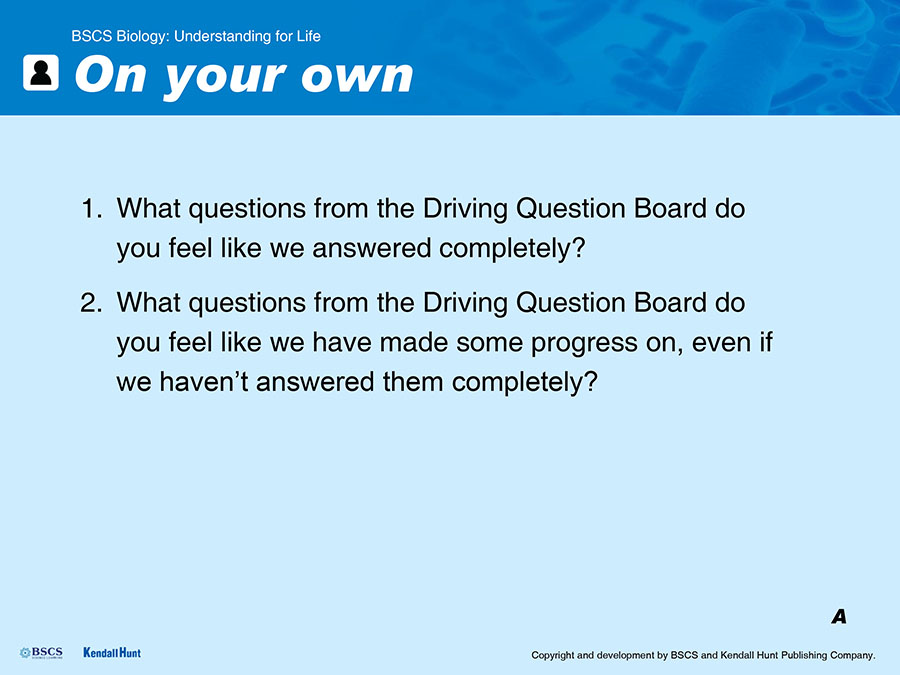

Attending to Student Ideas
Highlighting the fact that we are answering students’ own questions builds student agency by helping them see that, as a class, we are authentically interested in attending to students’ original questions. Encourage students to look for a question they originally wrote to see if we are able to answer it now.
Students share some of the questions they can answer.
Display Slide B. Ask students to share their ideas with their elbow partner, and to discuss what we did to help us answer that question. Then bring the class back together to share ideas with the whole group. Use the following prompts as an example of how to guide the discussion:
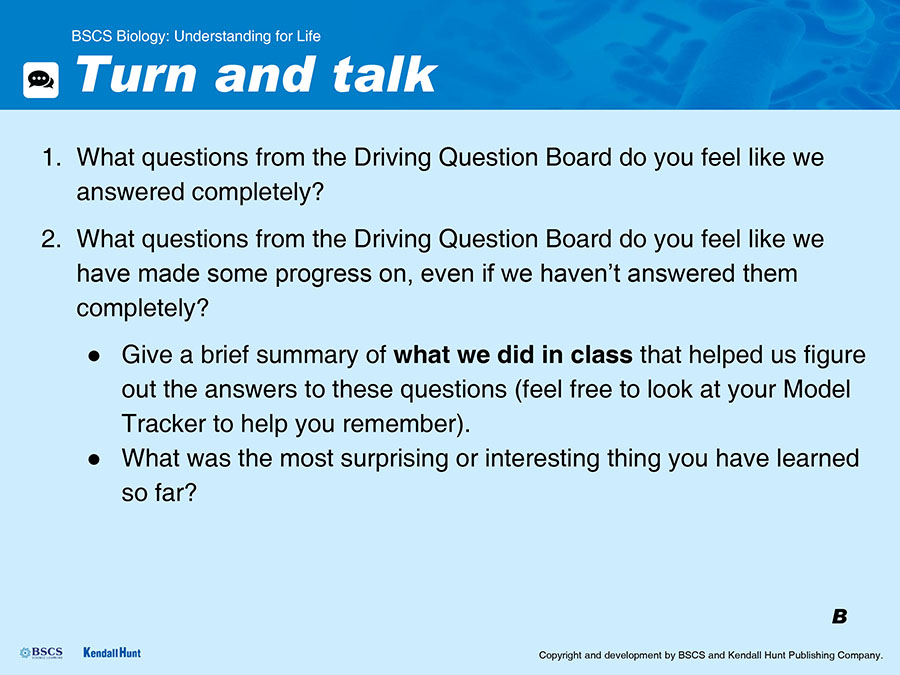

| Suggested prompts | Listen for student responses such as |
|---|---|
|
|
| Was there anything you figured out that surprised you? |
|
Students engage in a discussion to motivate the need to create a model to help us understand whether we can explain Zach’s case.
Think about whether what we learned so far helps us explain at least part of what happened to Zach—and more generally, How can bacteria cause infections? Pause to have students record this lesson question (or similar, using students’ own words) on the page they started for Lesson 5 in their science notebooks. Use the following prompts to guide a discussion about how we will try to answer this with a model:
| Suggested prompts | Listen for student responses such as |
|---|---|
| When we came in today, I asked you to look at some of the questions we had from the very beginning of the unit. Where did those questions come from? |
|
| What kinds of things did we do to help us ask those questions? |
|
| How did we use those questions? | We tried to think of investigations we could do to answer the questions. |
| Many of our investigations did not directly involve Zach. Do you think the patterns we found in our investigations would work to explain Zach’s situation? | The questions we investigated were the ones we thought we needed to know more about before we could figure out what happened to Zach, so we could go back and try to apply them to his case now. |
| As we learned new things we kept track of our ideas and how we might represent them in a model. How might we use that information? | We kept track of our ideas in our Model Tracker; we could try to put all of the ideas together in a new model to explain what happened to make him so sick. |
 CONNECT IDEAS TO MAKE SENSE
CONNECT IDEAS TO MAKE SENSE
PURPOSE | To make connections between ideas and evidence
Students gather in a Scientists Circle to make a collective plan for building our model to explain Zach’s (and other) cases.
Display Slide C. Ask students to gather in a Scientists Circle around a common area. This area should allow all students visual access to the DQB as well as any charts we created as a class so far. Have them bring their science notebooks open to their Model Trackers.
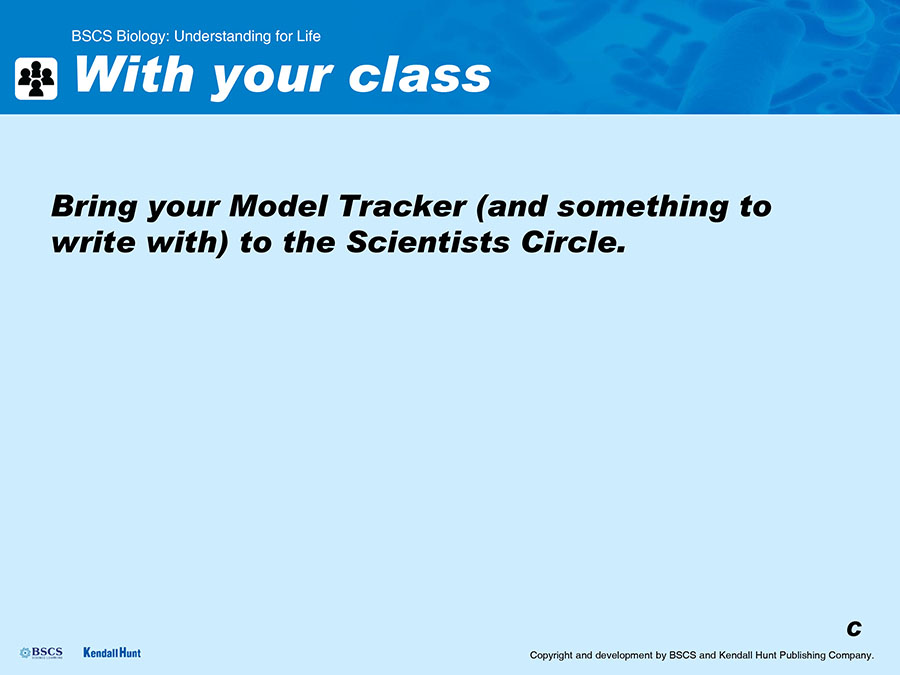

Literacy and Multilingual Learner Support
Having students sit in a Scientists Circle so they can see and face one another can help support discussion, increase engagement, and build a sense of shared mission as a community of learners working together. Remind students that we did this in Lesson 1 and are now going to get together again to discuss our progress.
Students engage in a whole-class discussion about what we want the model we build to do.
Show Slide D. Allow students to read the slide and reflect on what our model should be able to do. Then use the following prompts to facilitate the discussion:


| Suggested prompts | Listen for student responses such as |
|---|---|
| We just spent some time talking about what we figured out so far, and which questions we still have. Which questions do we need to make sure our model can help explain? | We want to explain how Zach and others with similar cases got sick. |
| Do any of the models we developed in each lesson explain how bacteria made Zach so sick as a “standalone” model? | Not really—in each lesson we only figured out one piece of the puzzle. |
|
|
| What can we do to organize what we will include in our model? | We could make a checklist of what to include in the model. |
| What are the things we’ve been looking for in our Model Tracker self-assessment checklist? Do you think we should look for these things in our bigger model, too? | Components, interactions, and showing how or why something works. These are how you tell if something is a good model, so our big model should have them, too. |
To prepare for building our “checklist,” students use the Model Tracker to highlight ideas that we should make sure to include in our model.
Display Slide E. Give students individual time to highlight the science ideas they think will be important to include in our explanatory model.
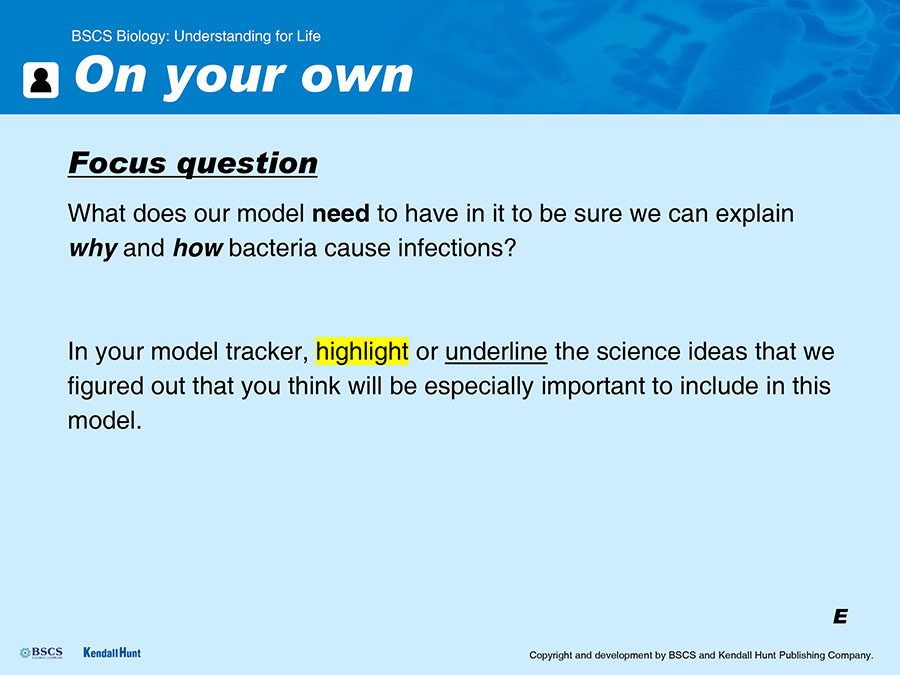

Literacy and Multilingual Learner Support
Working memory is very limited for any learner; the Model Tracker allows key pieces of information from multiple lessons to be accessed easily in one place. Providing this time for review and prioritization will ensure that all students can participate fully in the consensus building discussion.
Students compare ideas with a partner.
After students finish annotating their Model Tracker, show Slide F and give them some time to work with a partner to compare ideas and create a separate list of things they think must be represented in the final model.
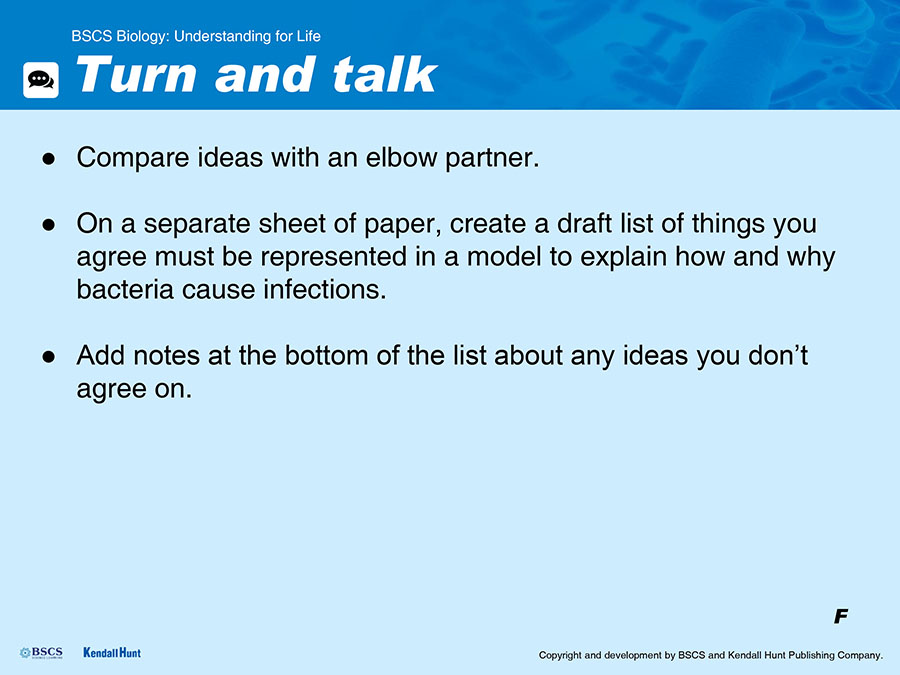

The class collaboratively builds a “Gotta-Have-It Checklist for the Class Consensus Model we will develop.
Share with students: So, we want to develop a model to explain: “What happens when we get infected with bacteria?” And we decided we could come up with a checklist of things our model has “gotta have.” Title a fresh piece of chart paper “Gotta-Have-It Checklist” and post it where the whole class can see it.
Have students contribute ideas to start building the Gotta-Have-It Checklist. Scaffold this by asking students to identify the components from their Model Trackers to start (use one color, e.g., blue, to record these), and then to build sentences that show how the components interact (use another color, e.g., green, to record these).
Take ideas from each group and record them on the chart paper until all ideas are recorded. If students give partial ideas, use clarifying questions to formulate more complete ideas.
| Components | Interactions |
|---|---|
|
|
Sample Gotta-Have-It Checklist.
Introduce the Communicating in Scientific Ways talk stems as a resource for discussions.
Have the Communicating in Scientific Ways talk stems posted somewhere visible to the whole class, and pass out a copy of Student Sheet 1.5.A: Communicating in Scientific Ways to each student. Have them attach it to a page in the back of their science notebooks with the other resources they will use throughout this unit and course.
Suggested framing: “In order to have the kind of collaborative science-based discussion we need to create a consensus model together, we might need some help with ways to start or structure our thoughts. Communicating in Scientific Ways gives us some helpful hints for forming our ideas into sentences. There are a lot of categories though, so I’ll give us some suggestions for where to look as we go.”
The class begins building a Class Consensus Model together.
To facilitate this discussion, ask for student input for how they want to represent the ideas on the Gotta-Have-It Checklist and use their ideas to start publicly drawing a diagrammatic model. For example, if students want to show shapes instead of colors for different bacteria, and a box to represent one system (with everything around it being another system), use those ideas.
Note: Throughout this section, one example is used to provide a stepwise illustration of a potential way to facilitate this discussion. At the end of this section there are examples of other ways the model could also be developed.
Use the following prompts to facilitate the process of using student ideas to co-construct the model:
| Suggested prompts | Listen for student responses such as |
|---|---|
| Let’s take a look at our Gotta-Have-It Checklist. Where do you think we should start? Do you think we can start with one of the models we already created and modify it, or should we start from scratch? | Those models are too specific—we need to make the whole thing more general, like we did in Lesson 4 with the symptoms. |
| What are the most important components to include as we get started? | We need to show bacteria for sure. We also need to show different environments if we want to be able to move bacteria to a new place to show what happens. |
| OK, let’s start with our different environments. How should we show that these environments are separated? | We could just split our paper in half and label them as two different systems. |
| Maybe we should use a more general term—an environment is a type of system right? If we generalize this as much as possible, we can try to use it to explain more situations. | We could draw a big square or circle, and have everything inside it be one system and everything outside it be the other system. |
| How could we show that the environments are different from one another? | We could have different types and amounts of bacteria in each environment to show they are different. |
| How will people looking at our model know that the bacteria are different? |
|
| How will people know what those different shapes or colors represent? | We need to include a key to show that they are different kinds. |
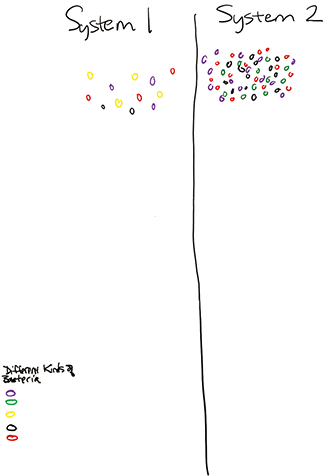
Sample of what the Class Consensus Model might look like so far.
Attending to Equity
If you have color-blind students, using different shapes instead of colors to represent different kinds of bacteria will be helpful. Alternatively, there are many websites that have information about what colors are useful for different color blindness types. Marker sets that have more color choices will have enough different shades of color that can be used so students who are color blind can still distinguish between the different colors.
Developing the Practices: Developing and Using Models
Students begin work on developing their first collaborative Class Consensus Model that illustrates the relationships between systems (the human body and external environment) to explain the causes of infection. While they will have some practice thinking about how to represent their ideas in models from using the Model Tracker in Lessons 2, 3, and 4, students will likely still need a lot of support for how to express their ideas to others and how to build on the ideas of others when creating an abstract representation.
Developing the Crosscutting Concepts: Systems and System Models
The Class Consensus Model is constructed through the lens of systems and system models. Students have considered boundaries, initial conditions, and inputs and outputs as they’ve worked on the models in their Model Tracker, so they should be familiar with the utility of including these in models. By understanding the boundaries of two key systems (inside the body and outside the body) and the differing initial conditions in each, students can make sense of differences in bacterial population growth in these different environments.
The class continues building the Class Consensus Model together.
It is important for students to build this knowledge together. Encourage students to clarify and expand on their own ideas as well as build on the ideas of others. Point out the “Listen to others’ ideas,” “Agree or disagree with others’ ideas,” and “Add on to someone else’s ideas” sections of Communicating in Scientific Ways and suggest to students to refer to these stems if they need help with this.
Ask students to also consider how these examples relate to the norms they started setting for this class during Lesson 1. For example, they may relate to norms such as:
Everyone gets a chance to share so we make sure that everyone feels safe, seen, and valued.
We pay attention to self and others by
monitoring how much we are speaking and
making sure others get opportunities to speak
Whenever you can, be sure to use students’ own words, revoicing their ideas to clarify their meaning as a way to authentically involve students in the construction of this Class Consensus Model.
Use the following prompts as a guide for continuing the build the model:
| Suggested prompts | Listen for student responses such as |
|---|---|
| OK, so are these populations growing? Can this depiction tell us that? | We’re not sure if these are growing; if they are just in their normal environment, they are probably stable, like we saw in our investigation. |
| How could we show population size, and whether or not a population is growing, without making this really messy and complicated? | We could use the population graphs to show how the bacteria are growing or not. |
| We said we know populations are limited by food and space. What could we use to represent whether a population is at its limit or not? | Populations grow exponentially, and when they reach their limit they stop growing. |
| How did we represent the idea that a population was at its growth limit in our investigation? | The graphs show a really fast growth rate at first, and then the rate slows as the population reaches the limit. |
| We said that each color represented a different kind of bacteria, so if we have four different colors, how many population growth lines will we need to show on this graph? | If there are four different kinds of bacteria, that means there are four populations, so we need four different lines. |
Literacy and Multilingual Learner Support
The Communicating in Scientific Ways stems have distinct sections, aligned to different aspects of scientific practice. Focusing students’ attention on a few at a time will make this resource manageable as they are introduced to it. They will have plenty of opportunities to explore it more throughout this course.

Sample of what the Class Consensus Model might look like so far.
The class continues building the Class Consensus Model together.
Use the following prompts to continue the process:
| Suggested prompts | Listen for student responses such as |
|---|---|
| When is all of this happening? Does it all happen at once? How do I know where to put the next part of this model? | We could show the bacteria from one of the environments getting moved to the other to show what can happen when there is a change in the system; that will be less static. |
| Is it important that we show these events happening in a certain order? | We used a timeline to keep track of what happened to Zach; we could add a timeline along the side of this model to show this is happening over time as well. |
| We are adding these ideas in a certain order, but if someone else tries to use our model (or if we come back later to use it), how will we understand that this didn’t just happen all at once? | We could show this happening in steps, or we could number the order. |
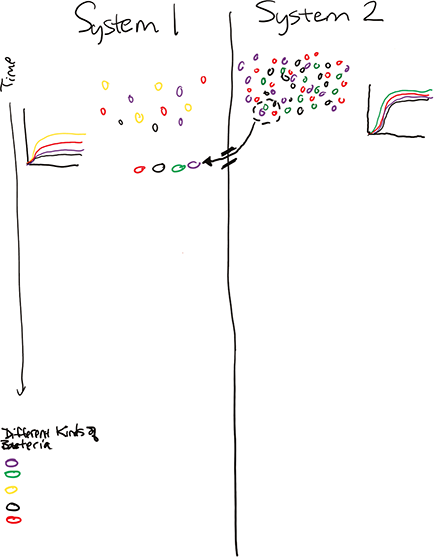
Sample of what the Class Consensus Model might look like so far.
The class continues building the Class Consensus Model together.
Use the following prompts to continue the process:
| Suggested prompts | Look for student responses such as |
|---|---|
| Great, we’re showing how the bacteria transfer from one environment to another. What will happen next? (Take a look at our Gotta-Have-It Checklist to help think about which important ideas we need to add.) | We need to show that the bacteria now grow exponentially. |
| Will all of the bacteria automatically start reproducing? Will they all reproduce at the same rate? | They won’t all grow; there are already some of the same kinds of bacteria there, and their populations are stable. |
| What did we learn in our investigations about the way bacteria grow in different environments? How could we represent that in our model? |
|
| So if I have just one kind of these bacteria that can start reproducing like crazy, how can we show that on this population graph? |
|
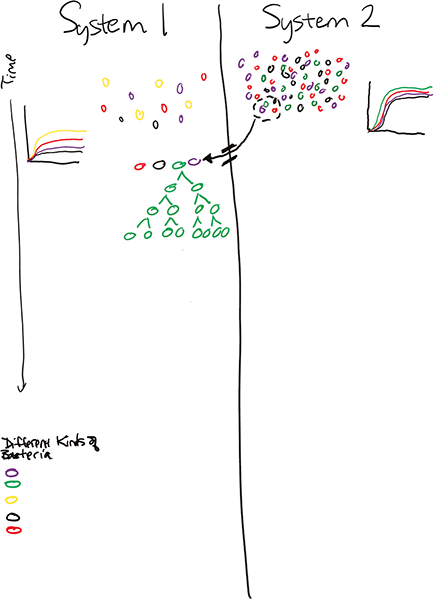
Sample of what the Class Consensus Model might look like so far.
The class continues building the Class Consensus Model together.
Use the following prompts to continue the process:
| Suggested prompts | Listen for student responses such as |
|---|---|
| OK, so it seems we have a change in the population now. How might we represent that? | We can show the new population all together so it can be seen more clearly. |
| Will our population growth graph look exactly the same as before? | We can create a new graph to show that one of the populations of bacteria is growing. |
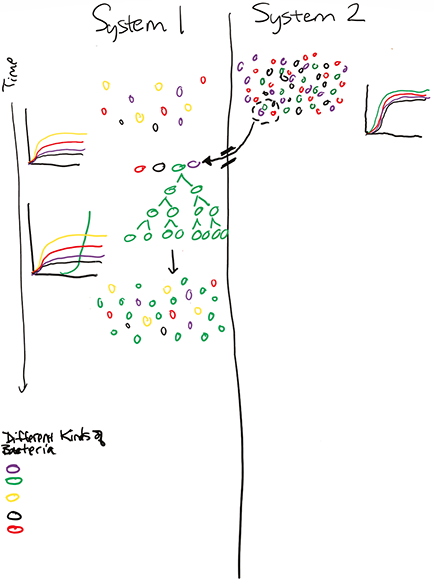
Sample of what the Class Consensus Model might look like so far.
The class continues building the Class Consensus Model together.
Use the following prompts to continue the process:
| Suggested prompts | Listen for student responses such as |
|---|---|
| It looks like we’re getting close to a good model. Are we missing any interactions from our Gotta-Have-It Checklist? | Bacteria release wastes and other substances; we could show that these substances are building up within the human body system. |
| Do all bacteria release the same kinds of substances? | No, it depends on the kind of bacteria. |
| So we have different substances based on the kind of bacteria we have. We probably need to add this to the key as well; how should we represent this? | Little dots could be the substances, and they could be different colors, depending on the bacteria. |
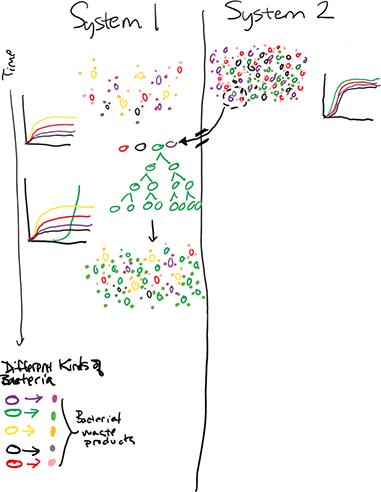
Sample of what the Class Consensus Model might look like so far.
The class continues building the Class Consensus Model together.
Use the following prompts to continue the process:
| Suggested prompts | Listen for student responses such as |
|---|---|
|
It seems like we’ve included everything, but there is one idea that I’m not sure we’ve shown yet: “Not all bacteria can live in all environments.” |
| What investigation led us to that? | When we (or the students who collected the data we looked at) disinfected the surface or washed our hands, and swabbed that area, fewer bacteria grew from those samples than from the swabs we took before cleaning. |
| That might be a good way to show this, but I’m afraid our model will get too confusing if we go back and kill some of the bacteria when we transfer them. I wonder if there is a way we can show what we did in our investigation on this model? | We could show that we add something to kill the bacteria to System 2, and then show what happens. |
| We’ve been keeping track of our population sizes and growth rates each time we make a change. What would this graph look like? |
|
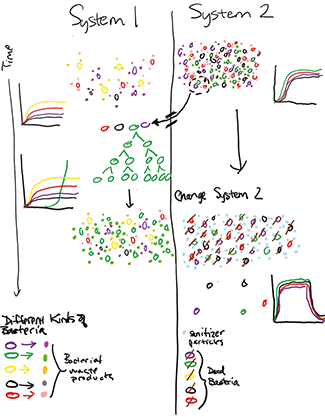
Sample of what the Class Consensus Model might look like so far.
Students reflect on whether we met the goal of explaining how and why bacteria can cause an infection.
Show Slide G. Remind the class that the purpose of this model is not to tell about the what and when but to explain the how and why. Show Slide H. Challenge the class to come up with a verbal explanation by using the model to see if it makes sense or if there are still some gaps we can fill with information from the Gotta-Have-It Checklist. Give students time to share ideas with an elbow partner before returning to discuss as a whole group.
|
X
X
|
X
X
|
The class discusses any final edits we want to make to our Class Consensus Model.
Use the following prompts to guide the discussion:
| Suggested prompts | Listen for student responses such as |
|---|---|
|
We know that the substances some bacteria produce can have an effect on body cells or tissues, in addition to other bacteria cells. |
|
No, both the bacterial cells and the substances they produce have interactions with other things in the system, so we need to show both. |
| Also, in this generic system there might not be cells; could we describe these as “other components of the system”? How could we show this without getting too detailed? | Maybe to keep it simple and still general we can add that idea to the key like we did for some of the other things? |
Developing the Crosscutting Concepts: Cause and Effect
Students work with the teacher and their peers to co-construct a consensus model that explains how what is happening in smaller-scale mechanisms (bacteria entering the body, finding plentiful resources, and engaging in life processes at the cellular level) can cause negative symptoms at the human body and organ systems level.
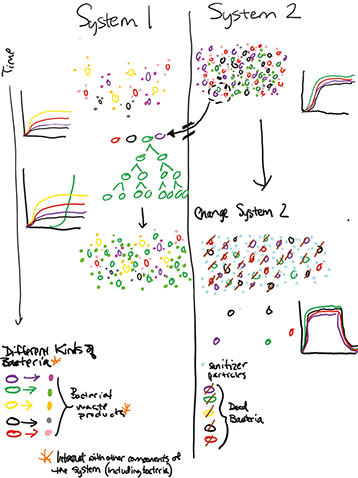
Sample of what the finalized Class Consensus Model might look like.
Attending to Student Ideas
Up until now we have been purposeful about keeping our model as general as possible. Adding some more specific interactions in a concrete way will help all students be successful in connecting this model to the explanations we will construct.
It is important to use students’ own ideas as much as possible. Use clarifying questions and lift up important pieces of student ideas to build on to help drive the consensus discussion toward a clear model.
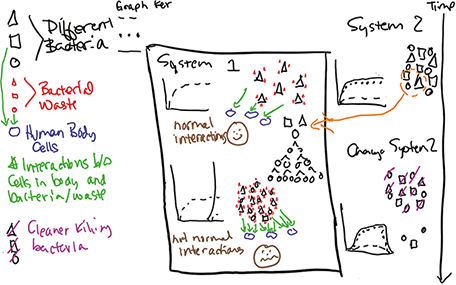
There are many ways these ideas could be represented. The images above and below are two additional (alternative) examples of the many possible ways a final consensus model might look.
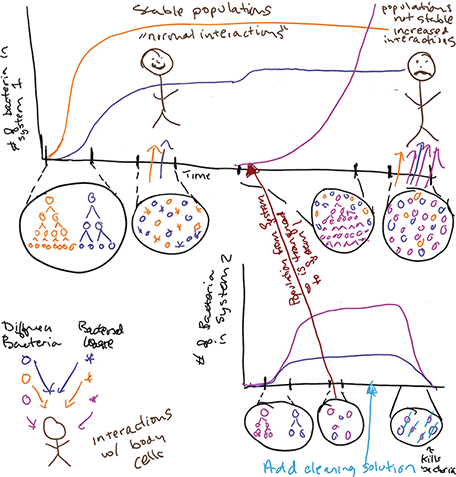

SUGGESTED CLASS PERIOD BREAK
End of Day 1
 REFLECT AND CONNECT
REFLECT AND CONNECT
PURPOSE | To reflect on our learning progress and process
Students reflect on how our ideas have changed and how the process of modeling facilitated this.
Show Slide I. Make students’ initial models (from Lesson 1) available to them. Facilitate a class discussion to reflect on the process of modeling. Point out the “Let your ideas change and grow” section of Communicating in Scientific Ways. Suggest that these stems might be helpful in capturing their reactions to seeing their initial models again.
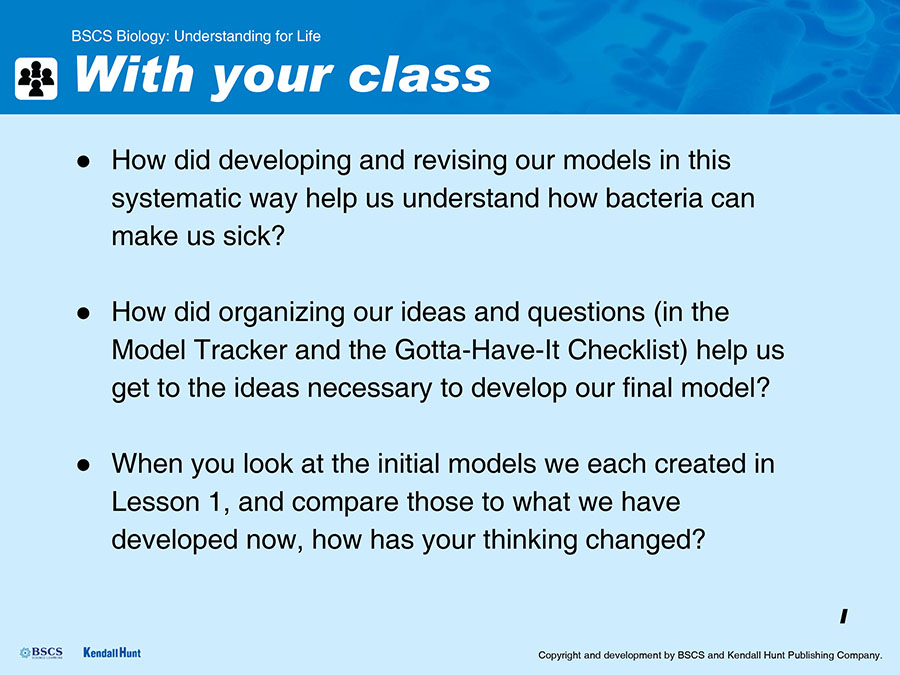

Suggested prompts:
How did developing and revising our models in this systematic way help us understand how bacteria can make us sick?
How did organizing our ideas and questions help us get to the ideas necessary to develop our final model?
When we look at the initial models we each created in Lesson 1, and compare those to what we have developed now, how has your thinking changed?
What did you learn about how bacteria make us sick?
What did you learn about creating a model?
Did you learn anything about the way you learn?
Student responses to these reflective questions will vary individually. Encourage students to identify and build on each other’s responses to foster a classroom culture of respect and empathy.
Attending to Student Ideas
If students are new to this type of learning, they often feel as if they “aren’t learning anything” because they’ve been taught that learning science is hard. Because this does not feel hard in the traditional sense (they are not studying to memorize lists of complicated science vocabulary, for example) they often mistakenly believe they are not learning.
It is important to make these ideas public and be transparent about the shift in understanding of how we learn best. This transparency is especially beneficial for students who have not been successful in traditional science learning environments up to this point. As they continually reflect on how much they have learned and how they can use it—without the nonproductive struggles they previously experienced—they also begin to understand they can be successful in science, and for many, this will increase their interest in science.
 UNDERSTANDING FOR ACTION
UNDERSTANDING FOR ACTION
PURPOSE | To apply understanding to plan or carry out action toward a solution for a societal issue
Connect back to our societal issue.
Ask students: How does knowing how infections start and can cause symptoms help us with this worrying issue we found out about in Lesson 1—that difficult-to-treat bacterial infections are getting more common?
Students consider multiple perspectives.
Engage the class in a discussion about the perspectives we’ve heard from.
| Suggested prompts | Listen for student responses such as |
|---|---|
| What perspectives did we hear from in Lesson 1? |
|
| What perspectives have we heard from since? Who should we make sure to include? |
|
Introduce some doctor perspectives on solutions.
Display Slide J. Tell students that the doctors whose perspectives they heard in Lesson 1 have ideas about actions we can take to help combat this problem. Give students each a copy of Student Sheet 1.5.B: Prevention Policies. Let students know that they will individually have the opportunity to expand on the models we developed in class and to apply what they learned to the issue the doctors were concerned about in Lesson 1.
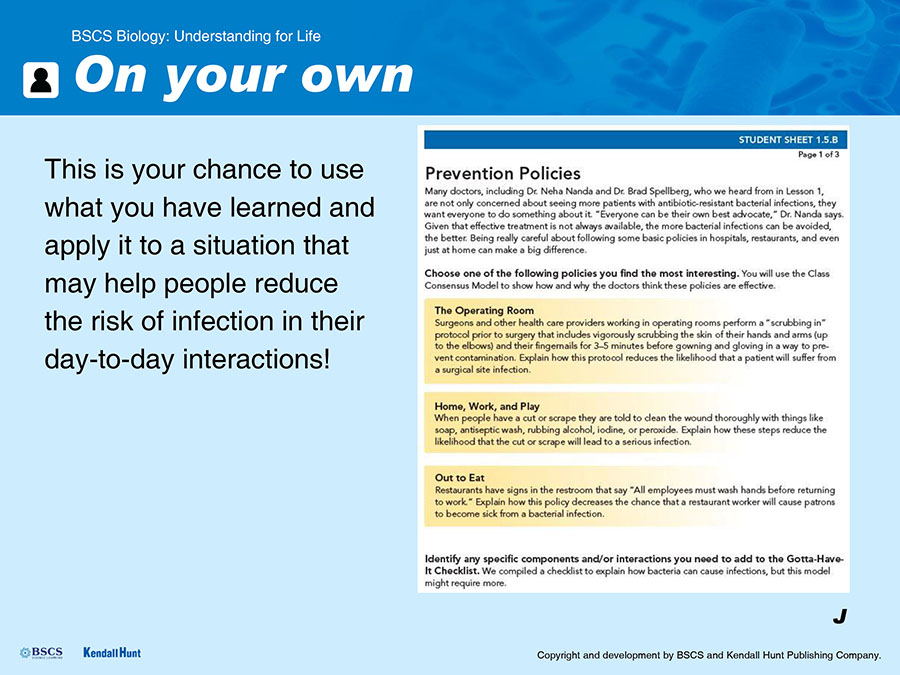

Students use their Class Consensus Model to evaluate how and why these solutions might be effective.
Give students time to individually choose one of the scenarios and develop a model to explain why this policy would be effective. Distribute colored pencils as an option for students while drawing their models. Make sure all students have visual access to the Gotta-Have-It Checklist and the Class Consensus Model.
Developing the Practices: Developing and Using Models
Building on the ideas and representations in their Class Consensus Model, students develop a model to explain the effectiveness of one of three basic prevention policies.

Sample student model to explain the Home, Work, and Play policy (ideas and representations will vary).
Formative Assessment Opportunity
The Prevention Policies task is an opportunity for students to see (for themselves) if they can use what they learned to explain a related idea. It is also an opportunity for you to see how well students understand the usefulness of building a Gotta-Have-It Checklist, and the applicability of their model to a variety of questions or problems. Look for students to be building off the structures of the Class Consensus Model (rather than “reinventing the wheel”), including all key components and interactions, and showing how or why their prevention policy works.
Students consider whether the science supporting these solutions is all that is needed for successful policy.
When students have finished their models, engage them in a discussion about the relationship between science and policy.
| Suggested prompts | Listen for student responses such as |
|---|---|
| These policies seem like good ideas, right? Can you think of any reasons why they might not work? |
|
| Do we think that just because the science supports a policy, it must be implemented? Are there any reasons that might cause problems? |
|
Students articulate potential actions, and evaluate readiness to take action.
Shift the discussion to considering how we might move from understanding to ideas for action.
| Suggested prompts | Listen for student responses such as |
|---|---|
| Do we still feel like the science provides good support for trying our best to implement these policies? | Now that we know more about how bacteria work, it makes a lot of sense to try to do these policies. |
| How might any of these policies relate to us and our school? |
|
| Are there any actions we could take to improve awareness? |
|
Depending on your school context, consider highlighting one or two student ideas and making a concrete plan to take action with them. If there are school policies or restrictions that would limit implementation of student ideas, validate their ideas and guide them to a more actionable task.
Students reflect on their own perspective.
Display Slide K. Give students a few moments to reflect quietly in their science notebooks. Student reflections will vary. Some may reflect that they never thought basic hygiene could relate to scary emergency room scenarios for themselves or others, but now see new connections.
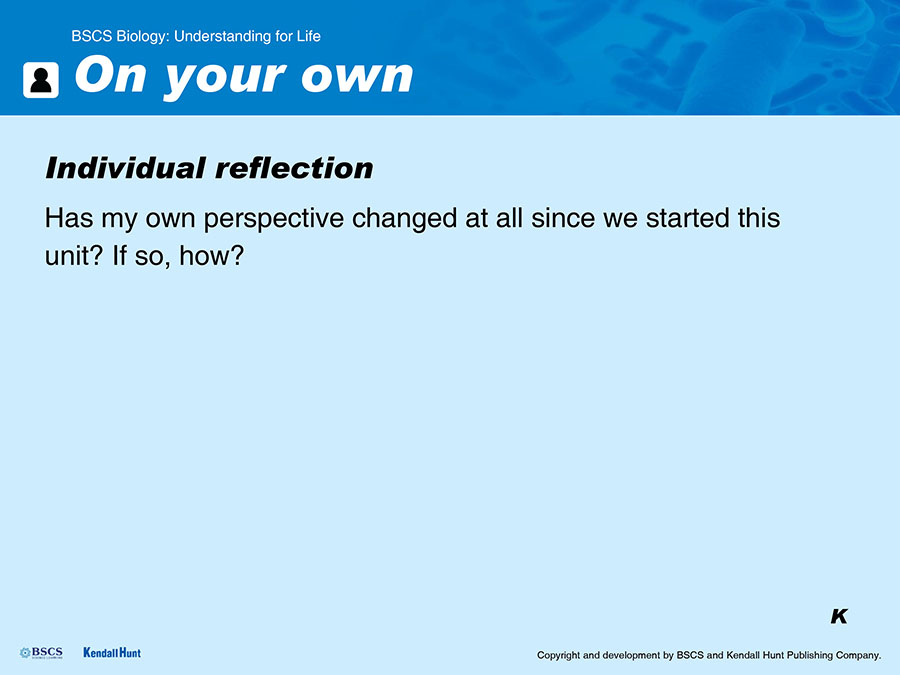

Meta Moment
Students will continually have opportunities to reflect on their own perspective and how it might change or shift over the course of the unit. The science notebook will provide a record of their thinking.
 NAVIGATE
NAVIGATE
PURPOSE | To maintain coherence and continuity
Celebrate the new skills and science understanding we have.
Suggested framing: “We’ve done a lot of learning and I’m excited to see how you all have used it to explain why these behaviors help reduce the rate of infections.”
Give students a chance to share their ideas about what they wrote about or any other ideas that relate to how they feel about their learning so far.
Surface some ideas we haven’t completely explained to motivate the need to figure out how to explain the rest of Zach’s story.
Look at our models and ask students to help clarify your thinking about some ideas to push them to search for an explanation. The purpose of this move is to surface more than one competing idea, which leads to students realizing they still need to investigate this to completely answer the question.
Suggested prompts:
OK, so we said that the high number of interactions between our body cells and bacteria (and their waste) causes the symptoms of an infection, but I’m not sure I understand how that happens yet. Can someone use our model to explain that part to me?
I’m also a little confused about the bacterial growth. I know that there have been times that I had a cut and didn’t clean it out or use an antibiotic ointment, and I was fine. If this was how it worked, wouldn’t we all be getting a lot more infections? Does our model really explain this?
Listen for student ideas that raise conflicting ideas and encourage as many competing ideas to help explain these two questions. Encourage students to come forward and to question each other, and to push each other to use evidence and reasoning in their explanations.
Ask students to jot down any new questions they might be wondering about, and add them to our Driving Question Board using sticky notes and fine-point markers.
Motivate students to engage in the Chapter Assessment.
After completing this Synthesize Lesson, you may choose to have students take the Chapter Assessment. Let students know that this assessment is a chance to show what they know, both in familiar contexts and less familiar ones.
If at all possible, make sure students receive their individual feedback based on the Model Tracker Formative Assessment you did at the end of Lesson 4 before having students take the Chapter Assessment.
REFERENCES
Childress, Sarah. “Dr. Brad Spellberg: Antibiotic Resistance Is ‘Everyone’s Fault’”. Frontline. Public Broadcasting Service. October 22nd, 2013. https://www.pbs.org/wgbh/frontline/article/dr-brad-spellberg-antibiotic-resistance-is-everyones-fault/ (Student Sheet 1.5.B: Prevention Policies)
Lemmen, S. W., and K. Lewalter. “Antibiotic stewardship and horizontal infection control are more effective than screening, isolation and eradication.” Infection 46, no. 5 (2018): 581–590. (Additional content background for the teacher)
Pearson, Candance. “As more bacteria grow resistant to antibiotics, scientists are fighting back.” Phys.org. University of Southern California. January 22, 2021. https://phys.org/news/2021-01-bacteria-resistant-antibiotics-scientists.html (Student Sheet 1.5.B: Prevention Policies).







